engine JAGUAR XJ6 1994 2.G Workshop Manual
[x] Cancel search | Manufacturer: JAGUAR, Model Year: 1994, Model line: XJ6, Model: JAGUAR XJ6 1994 2.GPages: 521, PDF Size: 17.35 MB
Page 398 of 521

0
Engine Bay Fuse Box - right-hand side
Fuse No. Fuse Colour Code
- F1
F2 Red
F3
F4 Red
F5 Red
-
F6 Tan
F7 Clear
F8 Red
F9 -
FIO Tan
F12 Red
F13 Red
F14 Red F15
-
F16 Red
F17 Light Green
F18 Red
Value
(amps)
10
10
10
5
25
10
-
5
20
10
10
10
10
30
10
Circuit
Not used
Main beam headlamp
- right-hand side
Not used
Lowered beam
headlamD - riaht-hand side ."
Side light -front right-hand side
Turn indicator
-front right-hand side
Side repeater flasher
- right-hand side
Engine control module
(ECM)
Air pump (6 cyl. - where fitted)
Ignition coils
(VIZ)
Air conditioning clutch
Not used
Generator
Front lighting control module
- right-hand
Air conditioning clutch
Windshield wash
J headlamp power wash heaters and relays
Engine management system relay supply
Injectors
Engine management system
Starter relay Ignition coil sensing and air pump relay (6
cyl.)
Fuel injection relay
Engine management sensing
(VIZ)
Windshield washer pump
Lambda heaters
Idle speed control valve
Not used
Air pump control
Solenoid vacuum valve
(VIZ)
Water pump (supercharged)
Headlamp power wash pump
Front fog lamp
- right-hand side (where fitted)
0
0
Issue 1 August 1994 X300 VSM AI-95MY 15
Page 404 of 521
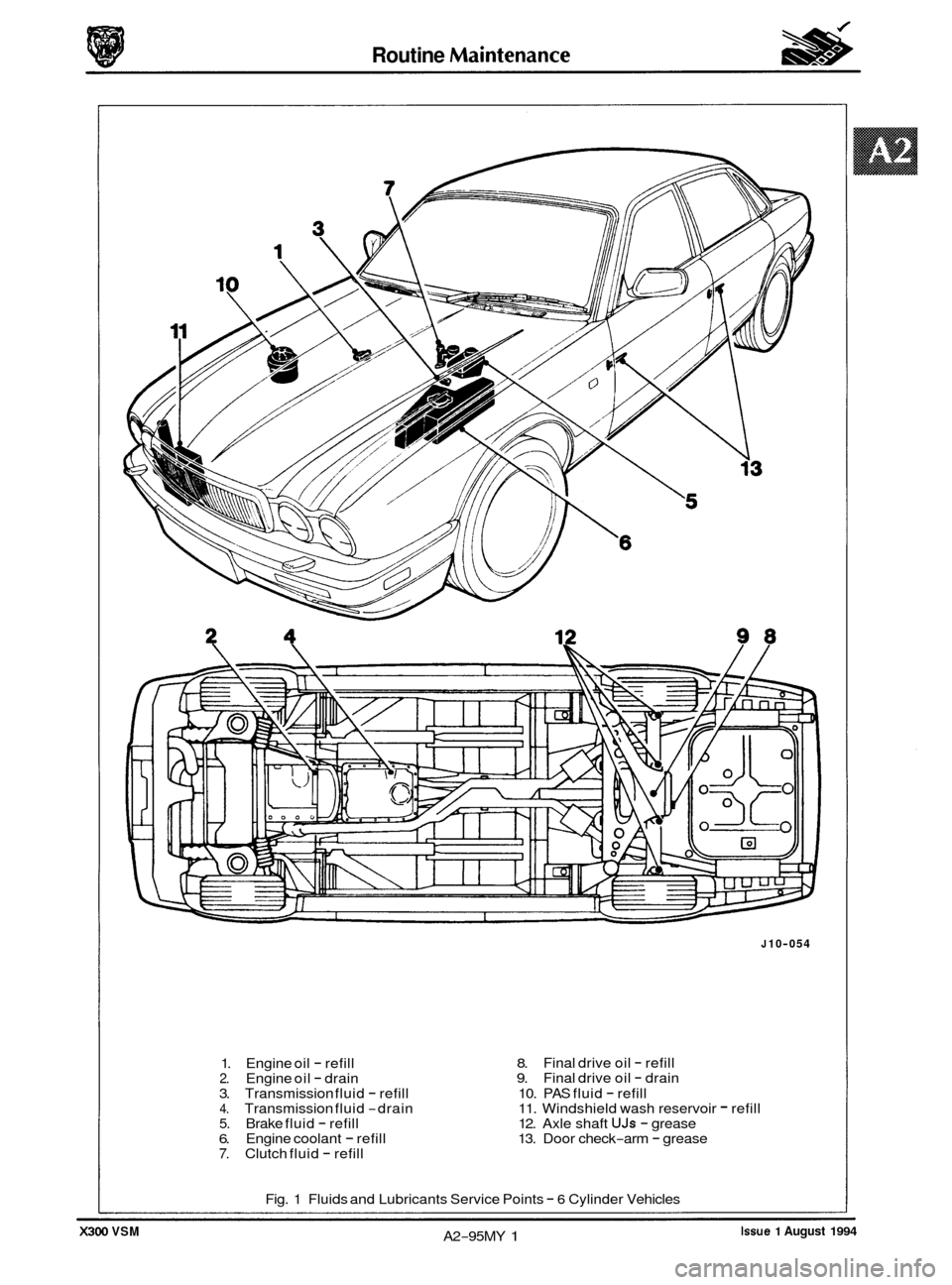
Routine
e
0
0
0
-
1. Engine oil - refill 2. Engine oil - drain
3. Transmission fluid - refill 4. Transmission fluid -drain 5. Brake fluid - refill 6. Engine coolant - refill 7. Clutch fluid - refill
J 10-054
8. 9.
10. PAS fluid
- refill
11. Windshield wash reservoir - refill
12. Axle shaft UJs - grease
13. Door check-arm - grease
Final
drive oil
- refill
Final drive oil - drain
Fig. 1 Fluids and Lubricants Service Points
- 6 Cylinder Vehicles
Issue 1 August 1994 A2-95MY 1 X300 VSM
Page 405 of 521
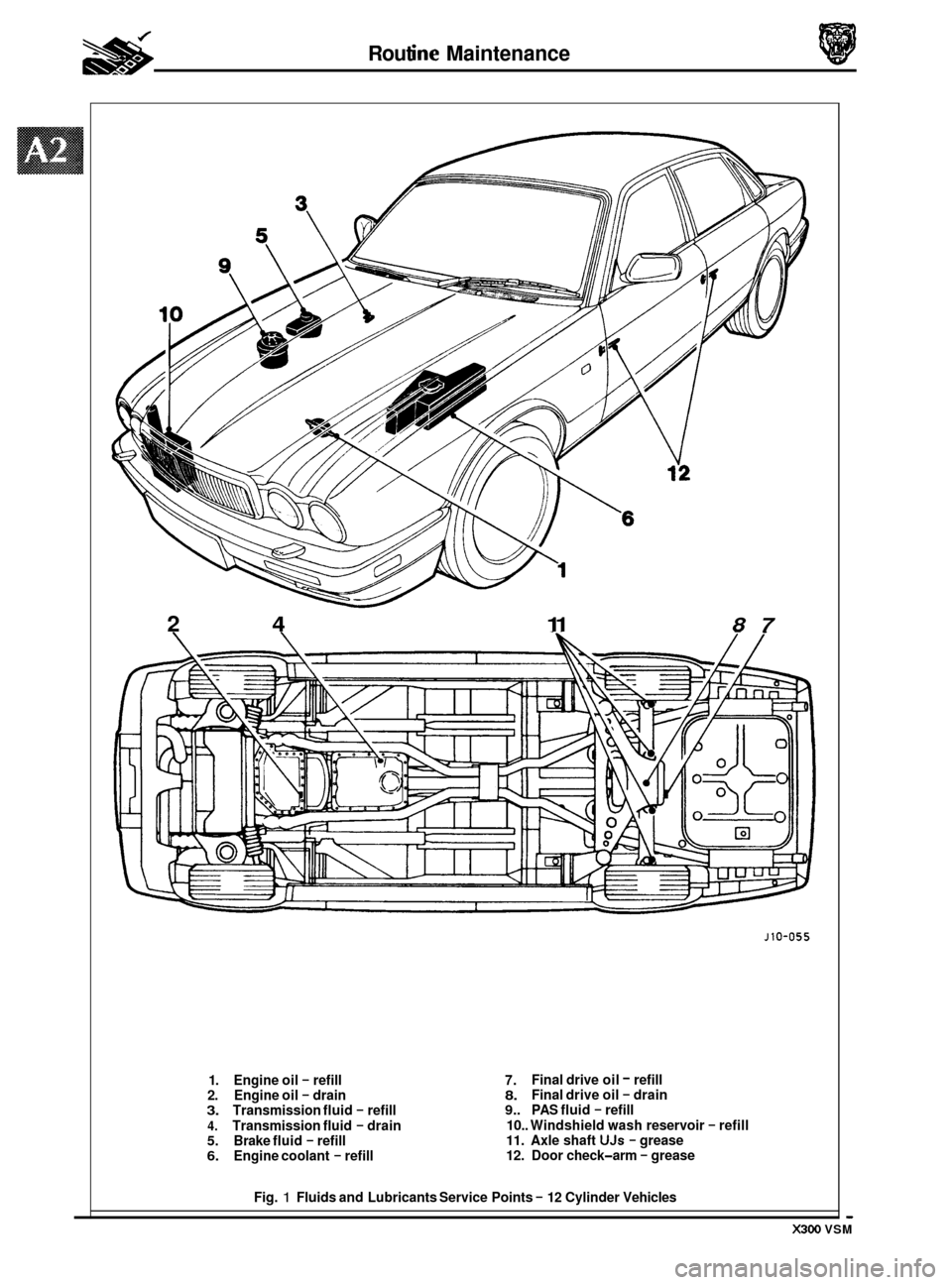
2 4 11 87
* * Rout ine Maintenance
- X300 VSM
1. Engine oil - refill
2. Engine oil - drain 3. Transmission fluid - refill
4. Transmission fluid - drain 5. Brake fluid - refill 6. Engine coolant - refill
J10-055
7. 8. 9.. PAS fluid - refill
10.. Windshield wash reservoir
- refill 11. Axle shaft UJs - grease
12. Door check-arm - grease
Final drive
oil
- refill
Final drive oil - drain
Fig.
1 Fluids and Lubricants Service Points - 12 Cylinder Vehicles
Page 406 of 521

Routine Maintenance
SERVICE SCHEDULE - UK, EUROPe ROW
3.2 Liter, 4.0 Liter, 4.0 Liter SC and 6.0 Liter
0
0
Note: This note only applies to VI2 engines.
When renewing spark plugs, apply silicon grease
(TBA) to the spark plug and coil terminals of the ignition
cable. This will ensure that the terminal covers remain supple throughout their service life, thus maintaining
a good contact and preventing HT leakage.
A2-95MY 3 Issue 1 August 1994 X300 VSM
Page 408 of 521
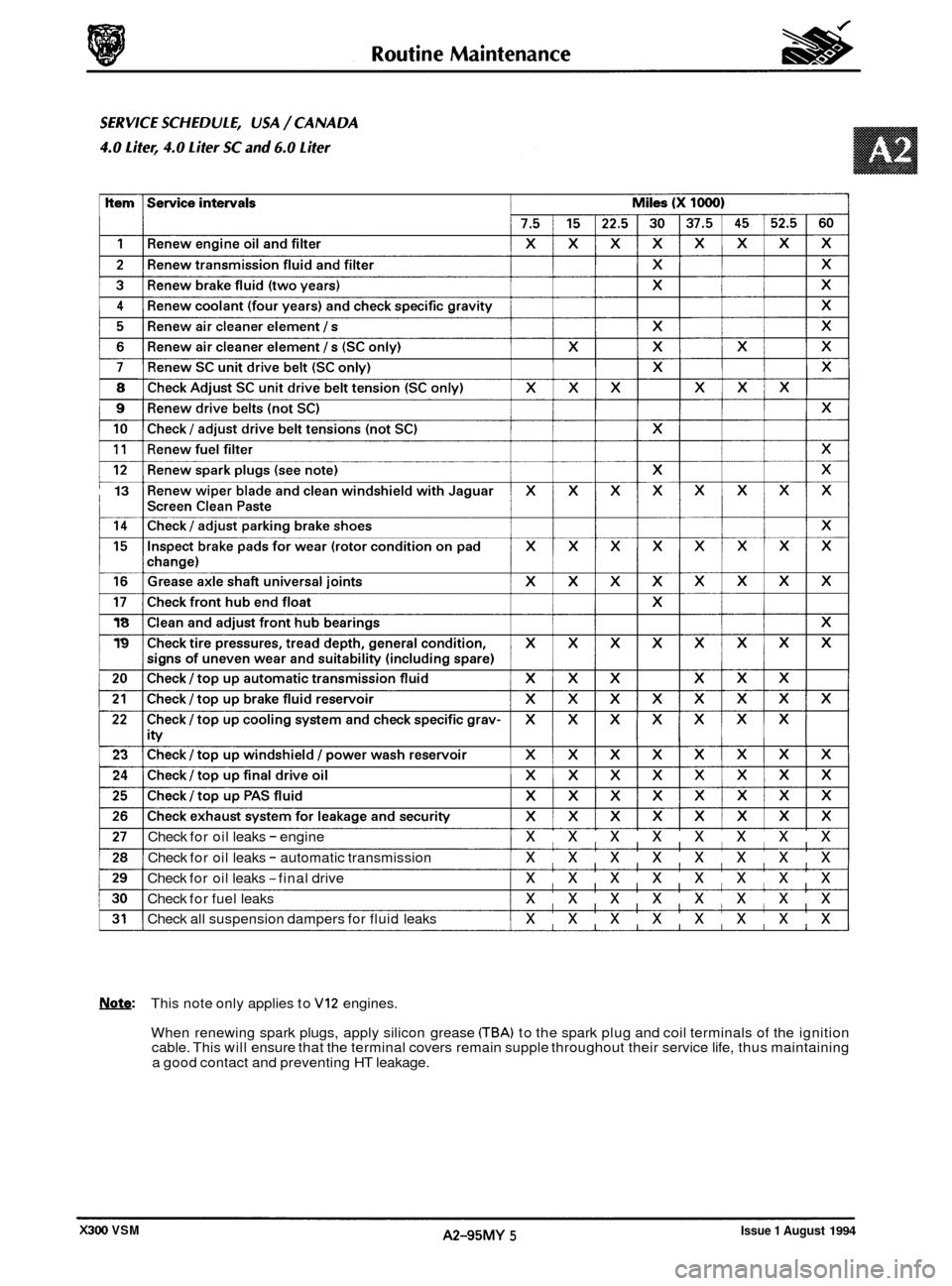
j
8
9
10
13 I
18
19
23
24
Check for oil leaks - engine xxxxxxxx
Check for oil leaks - automatic transmission xxxxxxxx
Check for oil leaks -final drive xxxxxxxx
Check for fuel leaks xxxxxxxx
Check all suspension dampers for fluid leaks xxxxxxxx
Note: This note only applies to VI2 engines.
When renewing spark plugs, apply silicon grease
CTBA) to the spark plug and coil terminals of the ignition
cable. This will ensure that the terminal covers remain supple throughout their service life, thus maintaining
a good contact and preventing HT leakage.
Issue 1 August 1994 A2-95MY 5 X300 VSM
Page 410 of 521
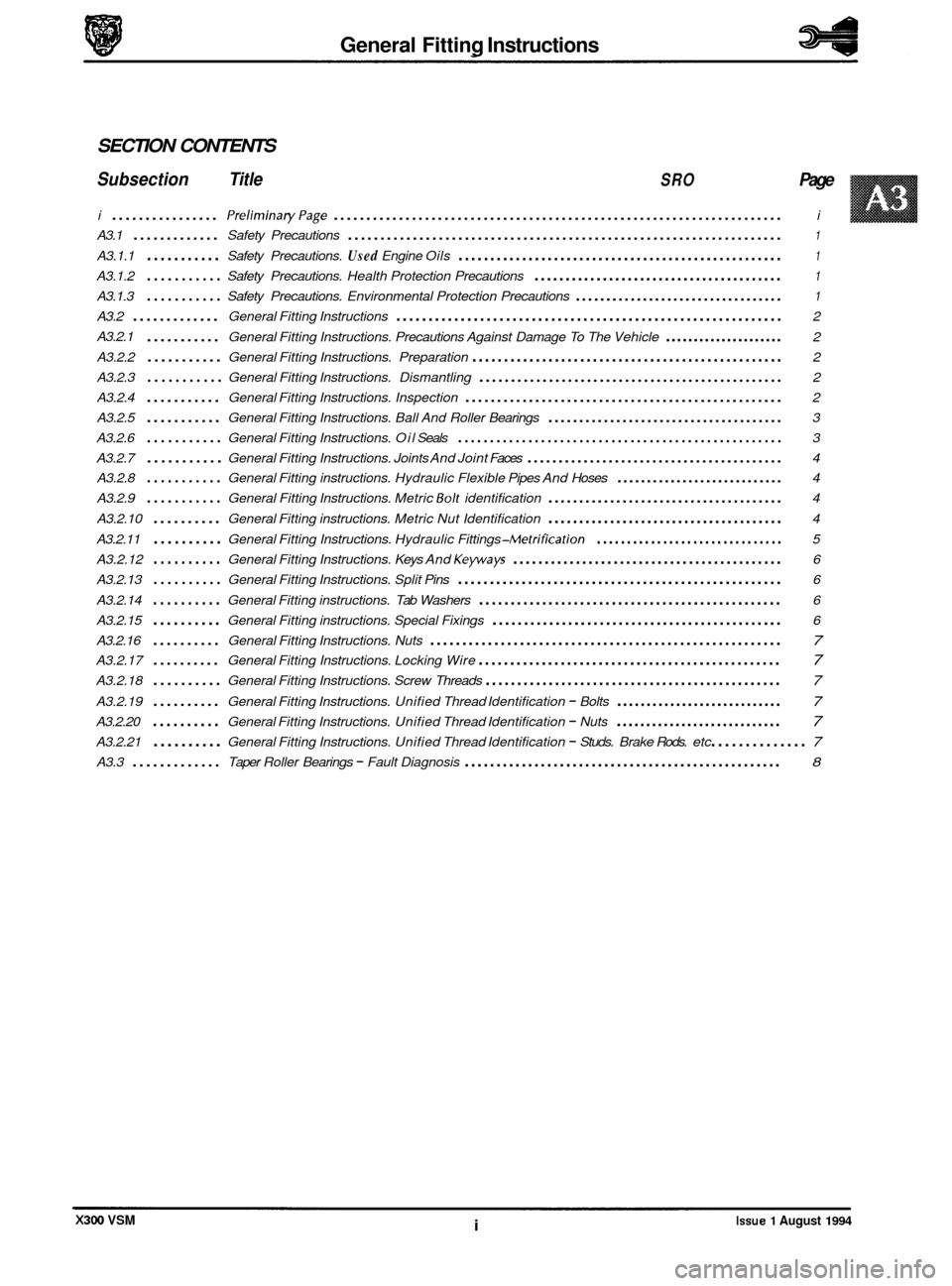
General Fitting Instructions
SECTION CONTENTS
Subsection Title SRO Page
i ................ PreliminaryPage ..................................................................... i
A3.1 ............. Safety Precautions ................................................................... 1
A3.1.1 ........... Safety Precautions. Used Engine Oils ................................................... 1
A3.1.2 ........... Safety Precautions. Health Protection Precautions ........................................ 1
A3.1.3 ........... Safety Precautions. Environmental Protection Precautions .................................. 1
A3.2 ............. General Fitting Instructions ............................................................ 2
A3.2.1
........... General Fitting Instructions. Precautions Against Damage To The Vehicle ..................... 2
A3.2.2
........... General Fitting Instructions. Preparation ................................................. 2
A3.2.3
........... General Fitting Instructions. Dismantling ................................................ 2
A3.2.4
........... General Fitting Instructions. Inspection .................................................. 2
A3.2.5
........... General Fitting Instructions. Ball And Roller Bearings ...................................... 3
A3.2.6
........... General Fitting Instructions. Oil Seals ................................................... 3
A3.2.7
........... General Fitting Instructions. Joints And Joint Faces ......................................... 4
A3.2.8
........... General Fitting instructions. Hydraulic Flexible Pipes And Hoses ............................ 4
A3.2.9
........... General Fitting Instructions. Metric Bolt identification ...................................... 4
A3.2.10
.......... General Fitting instructions. Metric Nut Identification ...................................... 4
A3.2.11
.......... General Fitting Instructions. Hydraulic Fittings -Metrification ............................... 5
A3.2.12
.......... General Fitting Instructions. Keys And Keyways ........................................... 6
A3.2.13
.......... General Fitting Instructions. Split Pins ................................................... 6
A3.2.14
.......... General Fitting instructions. Tab Washers ................................................ 6
A3.2.15
.......... General Fitting instructions. Special Fixings .............................................. 6
A3.2.16
.......... General Fitting Instructions. Nuts ....................................................... 7
A3.2.17 .......... General Fitting Instructions. Locking Wire ................................................ 7
A3.2.18 .......... General Fitting Instructions. Screw Threads ............................................... 7
A3.2.19 .......... General Fitting Instructions. Unified Thread Identification - Bolts ............................ 7
A3.2.20 .......... General Fitting Instructions. Unified Thread Identification - Nuts ............................ 7
A3.2.21 .......... General Fitting Instructions. Unified Thread Identification - Studs. Brake Rods. etc .............. 7
A3.3 ............. Taper Roller Bearings - Fault Diagnosis .................................................. 8
X300 VSM i Issue 1 August 1994
Page 412 of 521
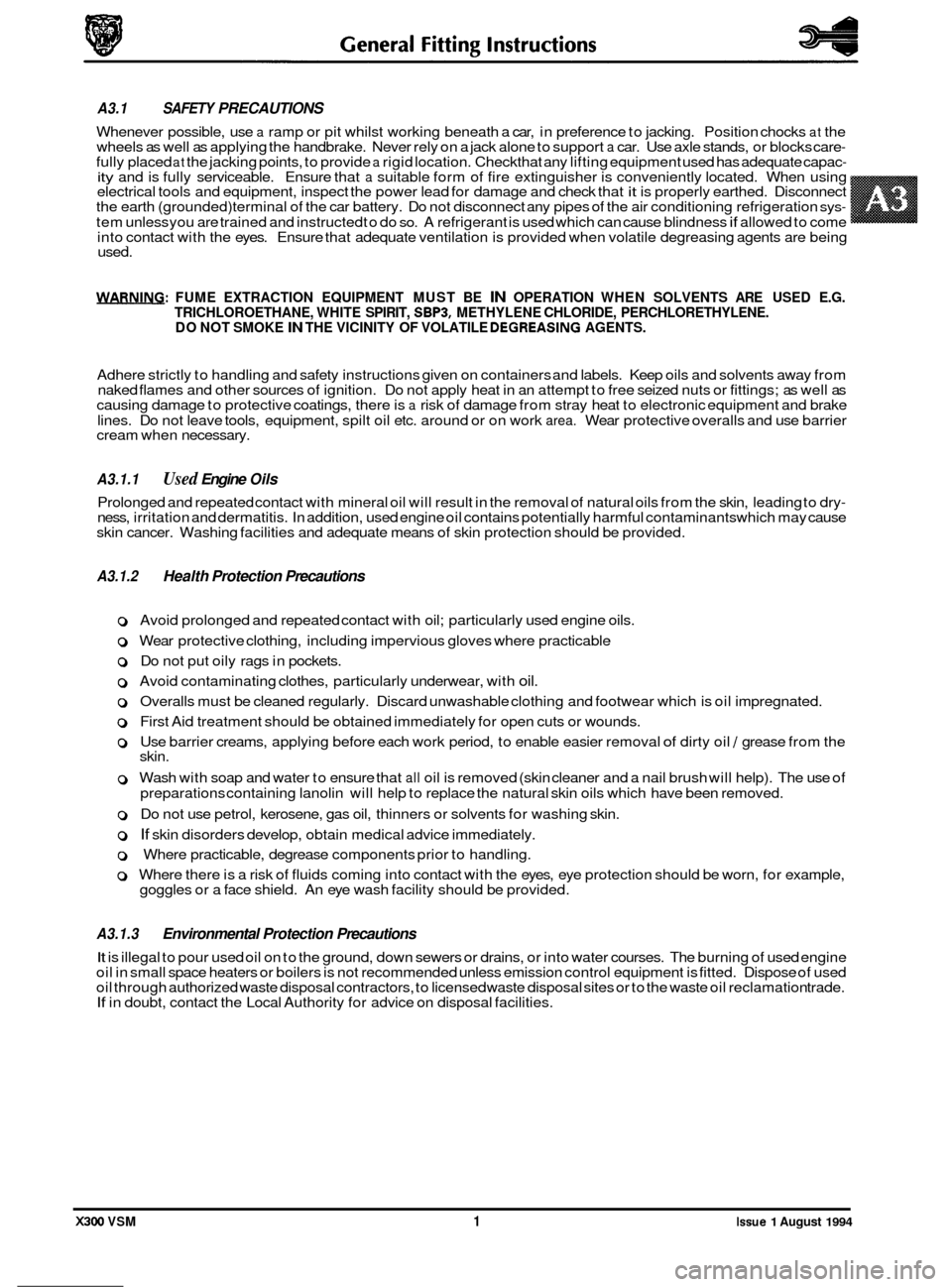
used.
WARNING: FUME EXTRACTION EQUIPMENT MUST BE IN OPERATION WHEN SOLVENTS ARE USED E.G.
TRICHLOROETHANE, WHITE SPIRIT, SBPB, METHYLENE CHLORIDE, PERCHLORETHYLENE.
DO NOT SMOKE IN THE VICINITY OF VOLATILE DEGREASING AGENTS.
Adhere strictly to handling and safety instructions given on containers and labels. Keep oils and solvents away from
naked flames and other sources of ignition. Do not apply heat in an attempt to free seized nuts or fittings; as well as
causing damage to protective coatings, there is
a risk of damage from stray heat to electronic equipment and brake
lines. Do not leave tools, equipment, spilt oil etc. around or on work
area. Wear protective overalls and use barrier
cream when necessary.
0 A3.1.1 Used Engine Oils
Prolonged and repeated contact with mineral oil will result in the removal of natural oils from the skin, leading to dry- ness, irritation and dermatitis. In addition, used engine oil contains potentially harmful contaminants which may cause
skin cancer. Washing facilities and adequate means of skin protection should be provided.
A3.1.2 Health Protection Precautions
0 Avoid prolonged and repeated contact with oil; particularly used engine oils.
o Wear protective clothing, including impervious gloves where practicable
0 Do not put oily rags in pockets.
0 Avoid contaminating clothes, particularly underwear, with oil.
0 Overalls must be cleaned regularly. Discard unwashable clothing and footwear which is oil impregnated.
o First Aid treatment should be obtained immediately for open cuts or wounds.
0 Use barrier creams, applying before each work period, to enable easier removal of dirty oil / grease from the
skin.
0 Wash with soap and water to ensure that all oil is removed (skin cleaner and a nail brush will help). The use of
preparations containing lanolin will help to replace the natural skin oils which have been removed.
o Do not use petrol, kerosene, gas oil, thinners or solvents for washing skin.
0 If skin disorders develop, obtain medical advice immediately.
0 Where practicable, degrease components prior to handling.
0 Where there is a risk of fluids coming into contact with the eyes, eye protection should be worn, for example,
goggles or a face shield. An eye wash facility should be provided.
A3.1.3 Environmental Protection Precautions
A3.1 SAFETY PRECAUTIONS
Whenever possible, use a ramp or pit whilst working beneath a car, in preference to jacking. Position chocks at the
wheels as well as applying the handbrake. Never rely on a jack alone to support a car. Use axle stands, or blocks care- fully placed at the jacking points, to provide a rigid location. Checkthat any lifting equipment used has adequate capac- ity and is fully serviceable. Ensure that a suitable form of fire extinguisher is conveniently located.
When using
electrical tools and equipment, inspect the power lead for damage and check that it is properly earthed. Disconnect
the earth (grounded) terminal of the car battery. Do not disconnect any pipes of the air conditioning refrigeration sys-
tem unless you are trained and instructed to do so. A refrigerant is used which can cause blindness if allowed to come
into contact with the eyes. Ensure that adequate ventilation is provided when volatile degreasing agents are being
It is illegal to pour used oil on to the ground, down sewers or drains, or into water courses. The burning of used engine
oil in small space heaters or boilers is not recommended unless emission control equipment is fitted. Dispose of used
oil through authorized waste disposal contractors, to licensed waste disposal sites or to the waste oil reclamation trade.
If in doubt, contact the Local Authority for advice on disposal facilities.
X300 VSM 1 Issue 1 August 1994
Page 413 of 521
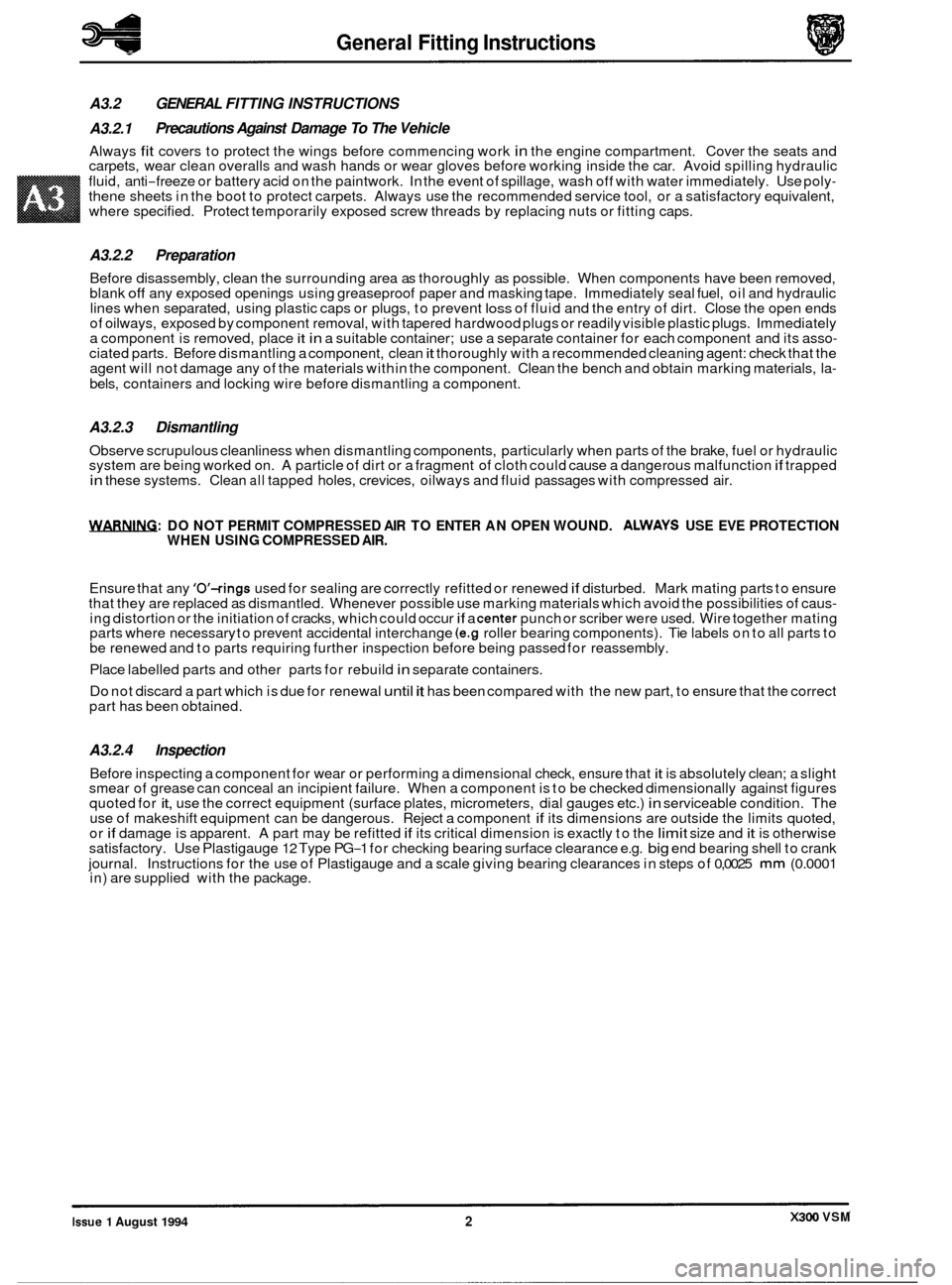
General Fitting Instructions
A3.2 GENERAL FITTING INSTRUCTIONS
A3.2.1
Always fit covers to protect the wings before commencing work in the engine compartment. Cover the seats and
carpets, wear clean overalls and wash hands or wear gloves before working inside the car. Avoid spilling hydraulic
fluid, anti
-freeze or battery acid on the paintwork. In the event of spillage, wash off with water immediately. Use poly- thene sheets in the boot to protect carpets. Always use the recommended service tool, or a satisfactory equivalent,
where specified. Protect temporarily exposed screw threads by replacing nuts or fitting caps.
Precautions Against Damage To The Vehicle
A3.2.2 Preparation
Before disassembly, clean the surrounding area as thoroughly as possible. When components have been removed,
blank off any exposed openings using greaseproof paper and masking tape. Immediately seal fuel, oil and hydraulic
lines when separated, using plastic caps or plugs, to prevent loss of fluid and the entry of dirt. Close the open ends
of oilways, exposed by component removal, with tapered hardwood plugs or readily visible plastic plugs. Immediately
a component is removed, place
it in a suitable container; use a separate container for each component and its asso- ciated parts. Before dismantling a component, clean it thoroughly with a recommended cleaning agent: check that the
agent will not damage any of the materials within the component. Clean the bench and obtain marking materials, la-
bels, containers and locking wire before dismantling a component.
A3.2.3 Dismantling
Observe scrupulous cleanliness when dismantling components, particularly when parts of the brake, fuel or hydraulic
system are being worked on. A particle of dirt or a fragment of cloth could cause a dangerous malfunction if trapped in these systems. Clean all tapped holes, crevices, oilways and fluid passages with compressed air.
WRNIFLG: DO NOT PERMIT COMPRESSED AIR TO ENTER AN OPEN WOUND. ALWAYS USE EVE PROTECTION
WHEN USING COMPRESSED AIR.
Ensure that any 'O'-rings used for sealing are correctly refitted or renewed if disturbed. Mark mating parts to ensure
that they are replaced as dismantled. Whenever possible use marking materials which avoid the possibilities of caus- ing distortion or the initiation of cracks, which could occur if a center punch or scriber were used. Wire together mating
parts where necessary to prevent accidental interchange (e.g roller bearing components). Tie labels on to all parts to
be renewed and to parts requiring further inspection before being passed for reassembly.
Place labelled parts and other parts for rebuild
in separate containers.
Do not discard a part which is due for renewal until it has been compared with the new part, to ensure that the correct
part has been obtained.
A3.2.4 Inspection
Before inspecting a component for wear or performing a dimensional check, ensure that it is absolutely clean; a slight
smear of grease can conceal an incipient failure. When a component is to be checked dimensionally against figures
quoted for
it, use the correct equipment (surface plates, micrometers, dial gauges etc.) in serviceable condition. The
use of makeshift equipment can be dangerous. Reject a component if its dimensions are outside the limits quoted,
or if damage is apparent. A part may be refitted if its critical dimension is exactly to the limit size and it is otherwise
satisfactory. Use Plastigauge 12 Type PG-1 for checking bearing surface clearance e.g. big end bearing shell to crank
journal. Instructions for the use of Plastigauge and a scale giving bearing clearances in steps of
0,0025 mm (0.0001
in) are supplied with the package.
0
0
0
X300 VSM Issue 1 August 1994 2
Page 415 of 521
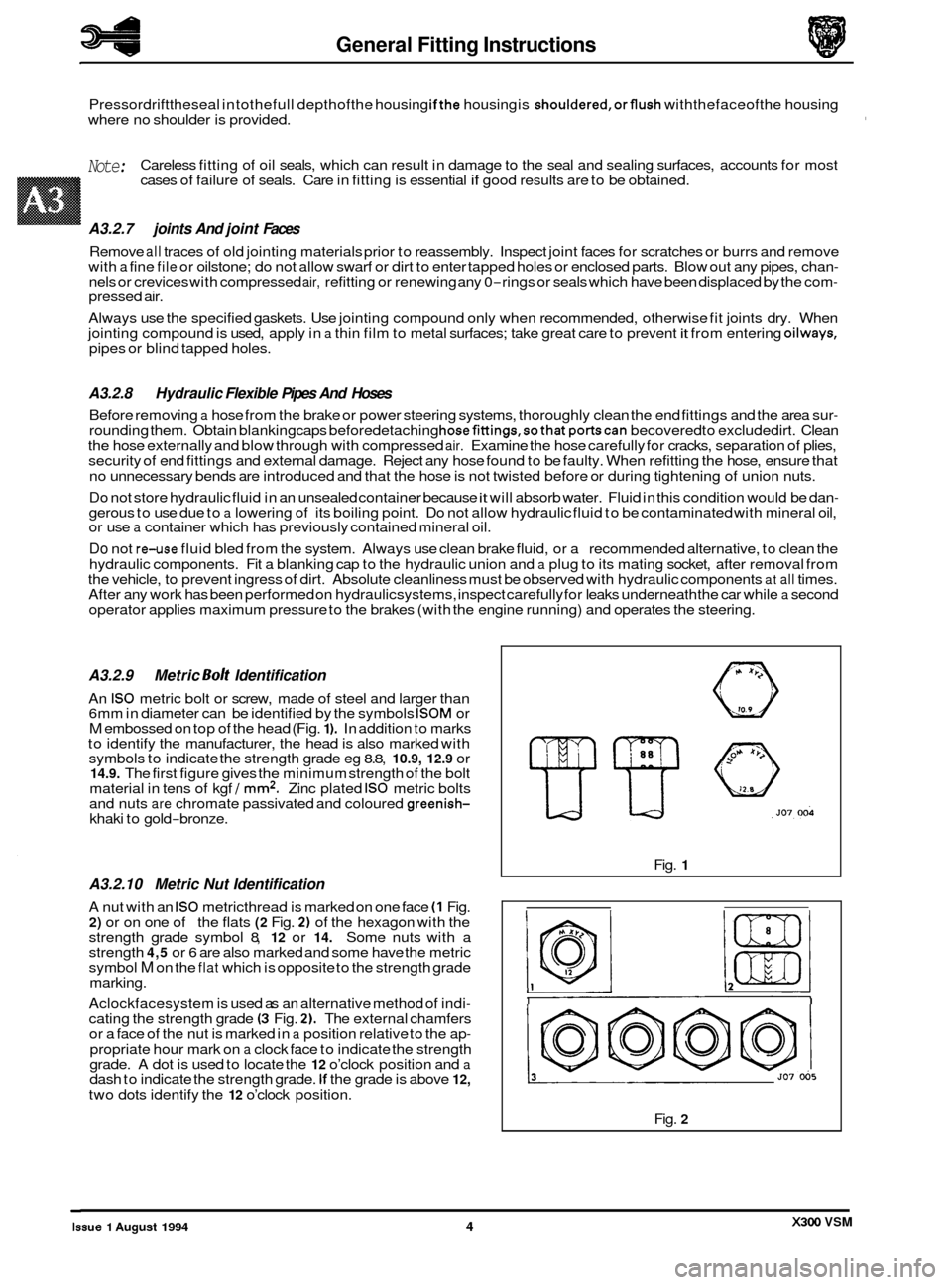
General Fitting Instructions
Pressordrifttheseal in tothefull depthofthe housing ifthe housing is shouldered,orflush withthefaceofthe housing
where no shoulder is provided.
Note: Careless fitting of oil seals, which can result in damage to the seal and sealing surfaces, accounts for most
cases of failure of seals. Care in fitting is essential
if good results are to be obtained.
A3.2.7 joints And joint Faces
Remove all traces of old jointing materials prior to reassembly. Inspect joint faces for scratches or burrs and remove
with a fine file or oilstone; do not allow swarf or dirt to enter tapped holes or enclosed parts. Blow out any pipes, chan- nels or crevices with compressed air, refitting or renewing any 0-rings or seals which have been displaced by the com- pressed air.
Always use the specified gaskets. Use jointing compound only when recommended, otherwise fit joints dry. When
jointing compound is used, apply in
a thin film to metal surfaces; take great care to prevent it from entering oilways, pipes or blind tapped holes.
A3.2.8
Before removing a hose from the brake or power steering systems, thoroughly clean the end fittings and the area sur- rounding them. Obtain blanking caps beforedetaching hosefittings,sothat portscan becovered to excludedirt. Clean
the hose externally and blow through with compressed air. Examine the hose carefully for cracks, separation of plies,
security of end fittings and external damage. Reject any hose found to be faulty. When refitting the hose, ensure that
no unnecessary bends are introduced and that the hose is not twisted before or during tightening of union nuts.
Do not store hydraulic fluid in an unsealed container because it will absorb water. Fluid in this condition would be dan- gerous to use due to a lowering of its boiling point. Do not allow hydraulic fluid to be contaminated with mineral oil,
or use a container which has previously contained mineral oil.
Do not re-use fluid bled from the system. Always use clean brake fluid, or a recommended alternative, to clean the
hydraulic components. Fit a blanking cap to the hydraulic union and
a plug to its mating socket, after removal from
the vehicle, to prevent ingress of dirt. Absolute cleanliness must be observed with hydraulic components at all times.
After any work has been performed on hydraulicsystems, inspect carefully for leaks underneath the car while a second
operator applies maximum pressure to the brakes (with the engine running) and operates the steering.
Hydraulic Flexible Pipes And Hoses
A3.2.9 Metric
Bolt Identification
An IS0 metric bolt or screw, made of steel and larger than
6mm in diameter can be identified by the symbols ISOM or M embossed on top of the head (Fig. 1 ). In addition to marks
to identify the manufacturer, the head is also marked with
symbols to indicate the strength grade eg
8.8, 10.9, 12.9 or 14.9. The first figure gives the minimum strength of the bolt
material in tens of kgf / mm2. Zinc plated IS0 metric bolts
and nuts are chromate passivated and coloured greenish- khaki to gold-bronze.
A3.2.10 Metric Nut Identification
A nut with an IS0 metricthread is marked on one face (1 Fig. 2) or on one of the flats (2 Fig. 2) of the hexagon with the
strength grade symbol 8, 12 or 14. Some nuts with a
strength 4,5 or 6 are also marked and some have the metric
symbol M on the flat which is opposite to the strength grade
marking.
Aclockfacesystem is used as an alternative method of indi
- cating the strength grade (3 Fig. 2). The external chamfers
or a face of the nut is marked in a position relative to the ap-
propriate hour mark on a clock face to indicate the strength
grade. A dot is used to locate the 12 o’clock position and a dash to indicate the strength grade. If the grade is above 12,
two dots identify the 12 o’clock position. Fig.
1
I I
Fig. 2
X300 VSM Issue 1 August 1994 4
Page 454 of 521

in the same location as the previous label, see location illustrations.
A protective mask is used to prevent the replacement part label from being damaged or obscured
during the refinishing / protection processes. This protective mask MUST be removed prior to customer hand-over.
m: All service panels are supplied in electrocoat primer and where appropriate MUST have an anti-theft label in the correct location.
A4.4.3.3 Procurement
Anti-theft labels may only be ordered from Jaguar Cars through:
Product Compliance Dept.,
Jaguar Inc.,
555 MacArthur Blvd.,
Mahwah
NJ
07430
A4.4.3 ANTI-THEFT LABELS, (NORTH AMERICAN MARKET ONLY)
A4.4.3.1 Original Components
North American specification vehicles have the VIN marked on all major external panels, certain structural members
and power/transmission units. The labelswhichcarry this information are known as 'Label -anti-theftVIN (USA body
panel only)' or 'Label - anti-theft - engine and gearbox (U.S.A. only)' (A Fig. I), see location illustrations.
A4.4.3.2 Replacement Components
When a vehicle suffers damage, only genuine Jaguar replacement panels / units should be used in the repair; further, if any parts originally carried a VIN label then a different type of label MUST be affixed 'Label - anti-theft replacement
part (USA body panel only)' or 'Label - anti-theft replacement part - engine and gearbox (U.S.A. only)' (B Fig. 11, NOT
A B
i f *
JAGUAR CARS VEH. IDENT. NO.
+ &
R DOT
JAGUAR
J76-IOL I
Fig. 1
issue 1 August 1994 27 X300 VSM